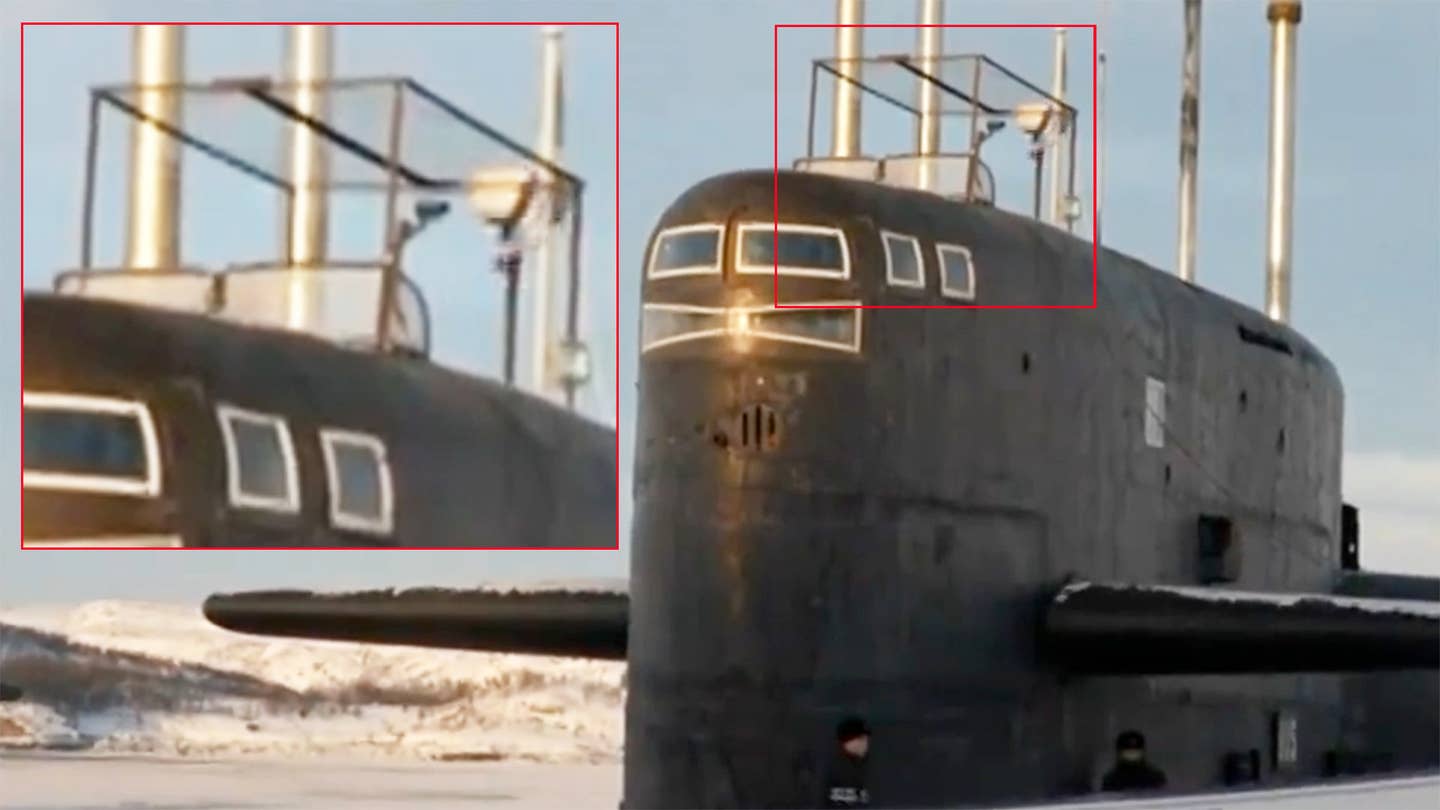Russian Submarines Now Appear To Be Getting Anti-Drone “Cope Cages”
An apparent counter-drone screen on the ballistic missile submarine Tula’s conning tower speaks to growing drone threats Russia is facing.

Russia's Delta-IV class nuclear ballistic missile submarine Tula now looks to be sporting an armor screen, commonly known as a "cope cage," on top of its conning tower to help protect against drones. This appears to be the first instance of this kind of add-on protection, which is now routinely used by both sides of the conflict in Ukraine on tanks and other armored vehicles, being installed on a naval vessel of any kind. This underscores the growing ubiquity of drone threats, something that Russia's armed forces are not alone in having to contend with.
Tula was first seen with the apparent drone countermeasure in a recent broadcast from the state-run Russia-24 television channel. The submarine, what is known in Russia as a Project 667BDRM or Delfin class boat, is assigned to the Russian Navy's Northern Fleet and is homeported in Gadzhiyevo in the country's far northern Murmansk region. Delta IV class submarines, each of which has a submerged displacement of around 15,500 tons, can be loaded with up to 16 R-29RMU Sineva submarine-launched ballistic missiles.
In the Russia-24 footage, which was reportedly shot earlier this month and a part of which can be seen in the social media post below, Tula is seen docked across from the Vepr, a Project 971U nuclear attack submarine, also known to NATO as the Akula II class. The far more streamlined Vepr has no screen on top of its conning tower.
Experts and observers have raised the possibility that the metal-framed structure on top of Tula's conning tower could also be part of a sun shade or be for some other purpose. It's also unclear what might happen to it if the submarine were to submerge with it attached. It would make the most sense for the screen to be relatively easy to install and remove as required, but it is unclear from what can be seen in the Russia-24 footage if this is the case.
Whatever the case, the screen's design, simple as it is, is completely in line with the kind of add-on counter-drone top armor that Russian forces first began installing on their tanks in the build-up to the all-out invasion of Ukraine in 2022. Armor of this type has since become a common feature on Russian and Ukrainian tanks and other armored vehicles, primarily as a defense against FPV and other types of weaponized commercial drones. A wide array of different armor screen designs have now been seen on a host of different vehicle types. Many of these are locally fabricated field modifications, but Russia's defense industry is now offering factory-produced standardized types.
Cage-type anti-drone armor has also now appeared on Israel Defense Force (IDF) tanks and other armored vehicles. An improvised armored truck, or "Narco Tank," belonging to a Mexican drug cartel also emerged with a counter-drone armor screen over its cab last year.
Gadzhiyevo is more than a thousand miles away from the front lines in Ukraine and also is out of reach of Ukraine's long-range kamikaze drones, at least the ones we know about now. Sabotage teams have been able to carry out attacks inside Russia, including with shorter-range weaponized drones. Those operations have occurred as far north as Russia's Pskov region, but this is still hundreds of miles south of Murmansk.
Still, the open top of a conning tower on a surfaced submarine, especially a highly valuable strategic nuclear ballistic missile type, would be an especially attractive target for a drone attack. In addition, submarines sail on the surface when entering and exiting port and sometimes also do so when transiting in peacetime through other congested waterways. At the same time, they have limited maneuverability while on the surface and lack the kinds of close-in defenses found on surface warships that could be used against threats like drones.
A successful drone attack on a submarine could be disastrous. Even a drone with a relatively small warhead could potentially trigger a devastating fire. A major blaze onboard a nuclear submarine could have major impacts beyond its hull, especially if it isn't far out to sea.
FPV drones, in particular, are highly maneuverable and have already demonstrated their ability to get inside armored vehicles through open hatches and into buildings through whatever openings might be available. Weaponized drones configured to drop improvised munitions have also proven able to get their payloads into hatches and other small spaces. Smaller drones, especially ones that move erratically, are inherently difficult to spot and shoot down.
With their high degrees of maneuverability, FPV drones have shown their ability to get around certain cage armor designs. This has, in turn, led to the emergence of increasingly more elaborate armor screen configurations on the battlefield in Ukraine.
Altogether, questions remain about the apparent counter-drone armor screen on Tula's conning tower and how effective it might be in practice. The emergence of the fixture on the submarine, hundreds of miles away from Ukraine, underscores how concerns about the dangers posed by weaponized drones, which are real now across all domains and only steadily growing worldwide. These are realities The War Zone routinely highlights.
On Sunday, Russian Defense Minister Sergei Shoigu visited the Black Sea Fleet's headquarters in Sevastopol on the occupied Crimean Peninsula. While there, he called for more defenses and better general preparedness against Ukrainian aerial drones and uncrewed surface vessels, the latter of which have sunk three Russian warships in the Black Sea since February.
So, regardless of how useful cage-style armor on top of the conning tower of a submarine might be, it does reflect threats that will increasingly need to be addressed, and not just by the Russian Navy.
Contact the author: joe@twz.com

